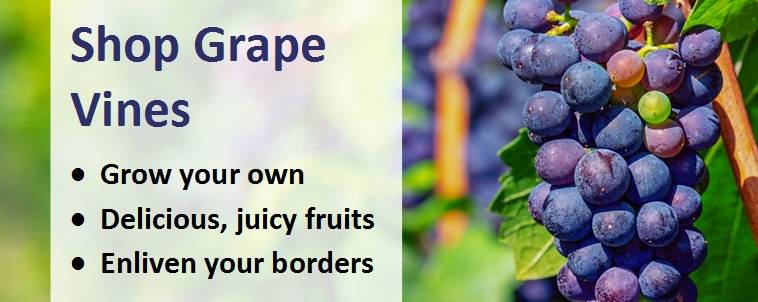Check Here Before Buying – Pot Size Matters...Not all websites offer the same. Plants in a 2-litre pot have twice the root system of a P9 or 1 litre pot.
How to Grow Your Own Grape Vines
Grape vines make an excellent addition to any garden or allotment. They can be trained up walls, trellis, arches or pergolas and look particularly stunning when laden with fruit. Grapes are surprisingly easy to grow - if you think about the vines with a little trepidation, take comfort from the fact that they're pretty difficult to kill, grow readily in the right conditions and can be kept at a height manageable for you. If cared for properly they make a good long-term investment, especially considering the amazing pleasure of picking a grape fresh off the vine and popping it into your mouth for your own home-made taste of Tuscany. Gardeners in the milder South of England will fare better with most varieties if grown outdoors, but there are hardier varieties such as grape vroege van der Laan and there is always the option of growing vines under glass in a greenhouse or conservatory.

Gardeners in the milder South of England will fare better with most grape varieties if grown outdoors
Fruit
There are two types of grapes - dessert grapes and wine grapes - although in practice many are suitable for both so the distinction is not always clear-cut. Using grapes to make drinkable wine is not easy and requires a degree of expert input; if you do want to be able to serve up a glass of your own homemade wine at a diner party, the best option is to find a vineyard that partners up with private, small-scale producers and use their expertise to get a good result. Far more straightforward is growing grapes for dessert or table eating - we recommend growing a few different varieties that will harvest consecutively. A cold winter, hot summer and late rain leads to the best cropping conditions. Picked grapes are best eaten fresh but will keep for up to 2 weeks if you're lucky enough to have an over-supply.
Recommended Grape Varieties
The best grape varieties are:
Grape Vroege van der Laan - one of the hardiest white grape varieties available, which will fruit reliably outdoors in most areas of the UK if grown in a sheltered, sunny position. Responds well to being kept compact for smaller gardens through regular pruning and produces grapes that are very sweet to taste when ripe, perfect for making wine or using as a dessert.
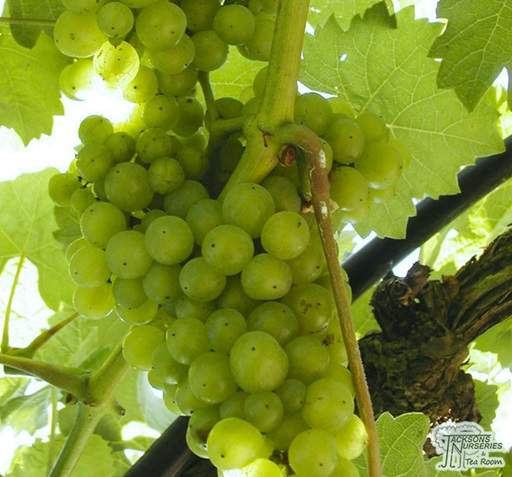
Grape Black Hamburg - bears masses of delicious black fruits with a sweet flavour that are great eaten fresh or used to make wine. Best grown indoors in all except the most mild southern parts of the UK to delivery a reliable crop.
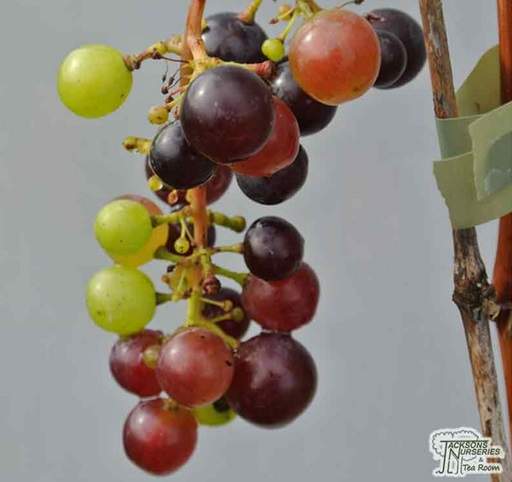
Vitis Purpurea (Purple Grape Vine) - award winning deciduous vine with lobed purple leaves that turn deep crimson in autumn, offering a superb contrast to red brick or stone. Deep purple grapes are edible but often left on the vine for ornamental value. Perfect for trailing over a trellis, pergola or arch, or scrambling up and along the branches of established trees.
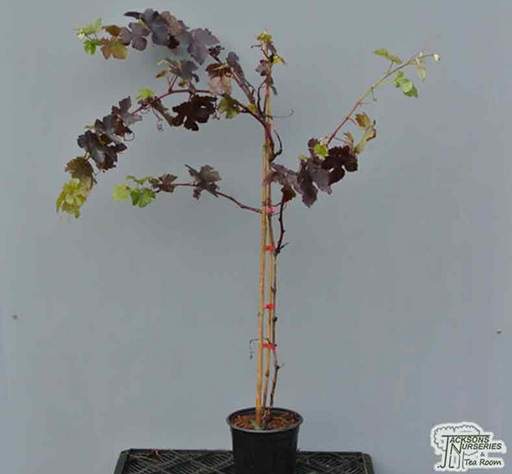
Location
Grape vines require a sunny, sheltered position, ideally against a south or south-west facing wall protected from frost pockets, in a deep, well-cultivated, free-draining soil. Carefully positioning vines away from trees and other large plants to ensure they receive full sun all day and making sure they're appropriately protected from biting frosts is key to getting a successful crop, so some planning at the outset is well worthwhile. If you intend to grow your vines in a row, plant the line north-south to allow sunlight to reach both sides of the plants. Growing rows in sloped and hilly areas with good drainage and ample sunlight can deliver good results. A lack of space need not prevent you from growing grape vines - they thrive in large pots and respond well to being regularly kept in check if their size needs to be restricted. In fact, many gardeners find that by restricting root growth in pots, the vines invest more energy in fruit rather than leaf production.
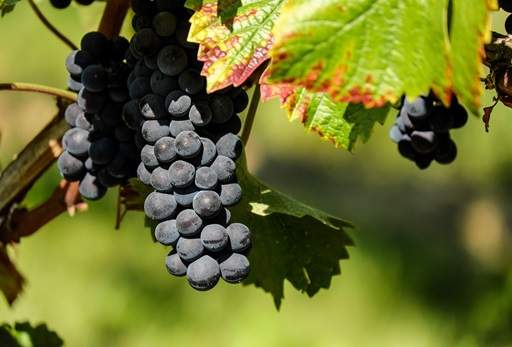
Grapes are best grown against a sunny, south-facing wall
Grapes can be grown outdoors in sunny sites in southern parts of the UK, but are best grown in an unheated greenhouse or conservatory in northern regions for a more reliable crop (they are often most successful under glass in warm southern locations too). Dessert grapes need to be grown in a greenhouse to ripen properly but then, during the winter, need to be allowed to get properly cold to allow the dormancy phase to set in. Good solutions include growing them in a container in the conservatory then putting them outdoors in the winter, or planting outside with the trunk and stems trained inside a greenhouse through gaps near ground level. Where this is not possible, the vines can be planted directly into the greenhouse border, but more irrigation will be required. Plant your vine at the opposite end to the greenhouse door, with the stems trained along the side of the greenhouse parallel to the ridge of the roof and running towards the door.
Deciding on a Growing Support System to Use
You will need to install a supporting structure to train your vine up or through, as it will sprawl unselfishly if left to its own devices. The Guyot system is a simple approach commonly used on commercial vineyards which also works very well for home-grown grape vines against a wall or fence. For vines grown inside greenhouses or conservatories, we recommend the rod ("cordon") and spur growing system. Growing your vines through a trellis is another good option - this is typically a wooden structure made of intertwined boards that allow the vines to wrap around them, providing a sturdy support system. A triangular system of strong canes with a grape plant grown from the base of each corner can look very attractive but is difficult to construct with enough strength to support vines as they become more established. Be sure to install your support system before you plant your new vines - don't just put them in the ground and worry about support afterwards!
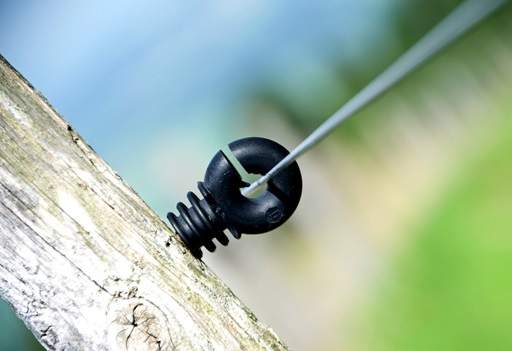
Install your support structure before planting your grapes
Guyot System
The guyot system can be used outdoors and works particularly well for vines grown against a wall or fence. Most well known for its use in commercial vineyards, it is easily adaptable for the home gardener. It involves installing horizontal galvanised support wires with the first 40cm (16 inches) above the ground, followed by 3 more at 30cm (12 inch) intervals. Wires can be easily secured using inexpensive but reliable and easy-to-use screw-in vine eyes. You'll notice the vine eyes are quite long - this is because you don't want your vine to grow right up against the fence, you want there to be enough room for a little air movement. Plant your grape vine next to the guyot support system and insert a cane behind the vine as a means of allowing the vine to access the support wires (as the vine grows to the higher wires, an alternative is to tie the leading lateral to the next wire that it's not able to reach itself using string). Tie the stump of the vine to the cane and secure the cane to the wire supports and your vine will have the support it needs to get started.
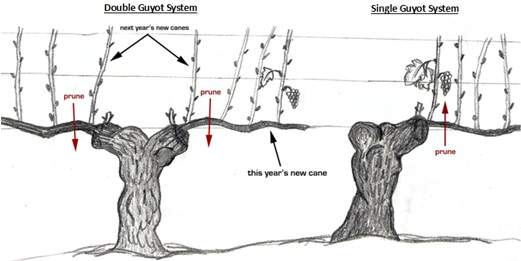
Illustration of Double and Single Guyot Systems
You can choose to spread one main stem in one direction from the plant's roots (single Guyot system), or two main stems in either direction from the plant's roots (double Guyot system), along the support wires. For the single Guyot, plant vines 1.2-1.5m apart, for the double Guyot allow 1.8m. After planting between October and March, cut back the main stem to 2 strong buds above the graft or above ground level then, in the first growing season, train one strong shoot vertically up a cane, pinching out any other shoots. In December, cut the main stem back to just above the lowest wire, cutting just above a bud. The following growing season, train 2-3 shoots rising from the buds that have been left and pinch any side shoots back to one leaf. In December of the second year, tie down your main stems to the lowest wire - in one direction for a single Guyot and in either direction from the base of the plant for a double Guyot and again cut shoots back to the furthest point when they stop being of pencil thickness. In subsequent years during the growing season the aim should be to train 3-4 shoots vertically up from the current years new cane (single Guyot) or canes (double Guyot) which are secured horizontally along the lowest wire. Tuck vertical fruit-carrying shoots through the higher wires and cut them back to 3 leaves above the top wire. Then, each December, remove the previous years horizontal canes leaving only the single vertical shoot closest to the centre of the plant (single Guyot) or 2 vertical shoots one either side closest to the centre of the plant (double Guyot). These will become next years' new horizontal canes so should be tied in against the lowest horizontal wire. This process constantly repeats with the new vertical shoot(s) closest to the centre of the plant becoming the horizontal cane(s) for the following year.
Rod ("Cordon") and Spur Pruning System
After planting between October and March by a support system with horizontal wires every 30cm from the ground, cut the main stem back by two-thirds and remove any side shoots to one bud. Then, during the first growing season when the main stem can be expected to reach the top of the support, pinch back the side branches to 5 leaves and the side shoots growing from the side branches to 1 leaf, tying the main step and side branches to the supporting wires. In December, reduce the length of the main stem by two-thirds and cut the side branches to one bud. In the second growing season, allow the main stem to continue growing and allow one side branch on either side of the main stem to produce a bunch of grapes, then pinch their tips back to 2 leaves beyond the bunch of grapes. Other side branches not bearing fruit should be pinched back to 5 leaves. In December following the second growing season cut back the main stem to half its length to a bud on mature brown wood and cut back side shoots to 2 strong buds. From year 3 onwards, untie the main stem to one-third of its length above ground every January, allowing the top part to bend down to the ground. This will encourage side branches to develop along the full length of the stem. Then, as soon as buds on the spurs begin to grow, tie the main stem back into the supports again. During the growing season, flowering side branches should be tied to a wire and non-flowering side branches pinched out to 5 leaves. On an on-going basis each December reduce the side branches to 1-2 buds from the main stem.
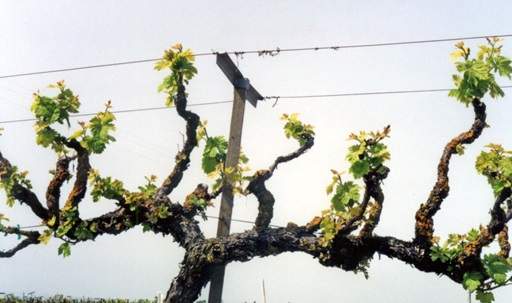
Rod ("Cordon") and Spur System
Container Grown Standard
Vines are best trained as standards where space is limited, with a single main stem and head of branches at the top. To train a standard tie the main stem into a thick bamboo cane inserted into the centre of the container, removing other stems that appear from the base. Side branches should be allowed to develop along the main stem for the first couple of years only, then fully removed up to two-thirds of the way up the main stem such that only the top third of side branches are left. Allow 3-4 branches to develop either side at the top, keeping them pruned to 5 leaves and any side shoots developing from the side branches to one leaf. Allow just one bunch of grapes to develop in the first fruiting year, removing all others; then, in subsequent years, look to harvest one bunch of grapes from each side branch. Side branches should be pruned back to 2 buds each year in November.
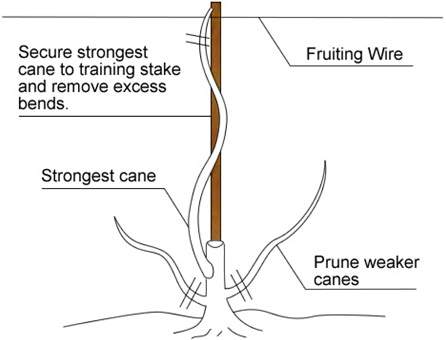
Guide to Growing a Grape Vine as a Standard
Planting Advice
Grape vines are best planted between October and March so the roots can become established over the dormant period. November and December are particularly good, as the vine can be pruned back without bleeding at this time of year. If growing against a wall plant 15cm away from the wall and 1.2m apart. Vines grown in the open should be planted 1.2-1.5m apart with rows 1.5-1.8m apart if you are planting multiple rows. Weed thoroughly, double-dig the ground then enrich your soil with fertiliser, compost or manure before planting. If your soil doesn't always drain well, dig a hole deeper than the depth of the rootball and remove any heavy clay sub-soil. When backfilling, this should be replaced with lots of old, well-rotted manure or garden compost, mixed with loamy top-soil and gravel or grit to improve drainage. Don't make the mistake of just putting in a lot of gravel or rubble at the bottom of the hole because this will just act as a soak-away, collect water and have the opposite effect. If you have an overly acidic soil sprinkle some lime over the surface of the soil to lower the pH, a neutral to slightly alkaline soil is ideal.
Aim to plant at the same level as the vines were in the pot. If planting a containerised specimen during the dormant season (October to March), tease the roots out a little bit to help establish more quickly. If planting during the summer time, it's best to leave the roots alone because you'll disturb them and set the growth back. Secure the ground around the plant down firmly once backfilling is complete to eliminate air pockets, as this is where your grape vines will put out new roots. If you are container growing your vine, use a loam-based compost such as John Innes No 3 and keep well watered during its early stints in hot, dry weather. Regardless of whether you choose to plant in the open ground or a container, don't be afraid to cut back to 3 strong buds above the ground after planting (yes, this may mean cutting off up to two-thirds of the length of the vines when supplied). Cutting back to these low, healthy, fat buds with ensure strong new growth from the base - it's no good cutting higher up where the buds are weaker and vines floppy.
Watering, Weeding & Feeding
Keep grapes grown outdoors well watered in their first year and during prolonged periods of dry weather, especially during the fruiting season as grapes will split if the plant lacks moisture. Indoor grapes will need regular on-going watering as they tend to dry out more easily. Keep weeds at bay by hand weeding on a regular basis and mulching with well-rotted garden compost or manure in spring to help retain moisture and suppress weeds. If you're growing your vine inside a greenhouse or conservatory, it's also a good idea to mulch with straw in the summer to keep the atmosphere dry, which will aid pollination and help deliver a more abundant crop. An alternative to mulching is using a mypex ground cover.
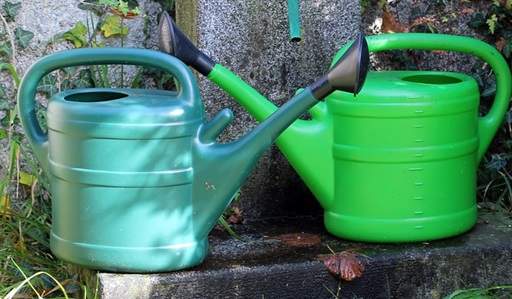
Keep grape vines well-watered, especially during the fruiting season
Grape vines are hungry plants and will need regular feeding during the growing season. Feed with a couple of handfuls of fish, blood and bone around the base of the plant in spring just before the growth starts and a handful every couple of months during the growing season thereafter. Additionally, apply tomato feed (high in potassium to support fruit growth) every 3-4 weeks. Once the vine is in full leaf, step up the feeding to weekly intervals to boost your crop for dessert grapes only, but stop as the grapes start to ripen as extra feeding at this time may ruin the flavour. If you're growing your grapes for wine, don't feed them as much; keeping the grapes smaller with a larger skin area will mean they are more flavoursome for wine making.
Pollination, Fruiting and Harvesting
In the first year after planting, vines should not be allowed to produce any fully matured fruits as these can damage the young vine with their weight. Thereafter, to aid pollination of grape vines grown in a greenhouse or conservatory, shake the vines firmly in the middle of sunny, dry days; this will help to transfer pollen between the flowers. As grapes start to develop, aim for quality rather than quantity by thinning them twice. Once the berries are set, they swell very quickly to the size of a pea and must then be thinned for the first time. Aim to take out at least half of the berries in every bunch with scissors to allow space for the remainder to fully develop and improve air circulation. If grapes are overcrowded as they swell further, a second round of thinning is encouraged. At the same time as thinning its good practice to remove any leaves directly between the remaining bunches and the sun, to prevent them casting a shadow over your grapes.
Check grapes a couple of times a week as they develop to remove any that are damaged or diseased, to prevent them from affecting other grapes nearby. Keep the greenhouse or conservatory temperature as constant as possible during fruit development by regulating ventilation as required. As harvest time nears, remember that grapes will not continue to ripen after picking, so don't be overly keen and pick them too early. Grapes are only ready for picking when they feel soft to the touch and have a sweet, sugary taste (the best way to check is by tasting them). When they're ready to harvest, cut them in bunches with the stalk still attached - pulling fruits from the stalks is likely to damage the grapes before they reach the table.
Pruning and Training
After planting your grape vine, some patience is required before you enjoy your first crop of fruit. All flowers should be removed for the first 2 years after planting - you'll have to accept you won't be able to harvest any fruit during this time - 3 bunches should then be allowed to develop on three-year old vines and 5 bunches on four-year old vines. Full cropping can be allowed thereafter. In terms of pruning more generally, vines can rarely be over-pruned providing you leave some well-ripened young wood. Prune between late November and December and try to choose the coldest winter day to prune to prevent vines from "bleeding". The rule of thumb to follow when pruning is to always cut back to the highest points where the vine is still of pencil thickness. When cut back to this level, your grape plant will send all its energy to the last 2-3 buds at the end of the stems to produce new laterals in order to expand.
If you're looking to maintain disciplined vines, also remove tendrils - the thin, twisty stem-like structures that curl around supports. This will force the plant to stick to your pruning and training regime, rather than rambling to its own devices, as well as preventing the tendrils from tangling with fruit and improving production (as plant energy is invested into fruit production not tendril growth). After you've cut back to the highest point of pencil thickness and removed tendrils, follow the training guidance for either the guyot or rod and spur training systems described above. Always clean up after pruning to prevent the spread of disease.
Pests & Diseases
If you're growing your grape plants outdoors, protect them from birds by laying a net over a timber or metal frame, or growing inside a bird cage. Mildew is the most common problem to affect grape vines, which is most likely to strike over-crowded vines in hot, dry weather. Tell-tale signs are dusty white coatings on leaves and foliage that becomes stunted or distorted. If your plants are affected, use a fungus killer spray and improve air circulation/relieve congestion through pruning and thinning out, starting with the most badly affected shoots.
Keep the vents of your greenhouse open during hot and humid summer and autumn days to improve air circulation and therefore reduce humidity which encourages fungal diseases, especially around flowering time. In winter, deep clean your greenhouse using Jeyes Fluid to minimise the risk of your vines being affected by pests and diseases - it's best to be scrupulously clean!

Protect your grapes from preying birds using netting
Top Tip: Sprinkling white gravel around the base of your vines not only helps suppress weeds but also reflects sunlight into the canopy of the grapevine, providing an extra boost to your vines.
Share this page:

